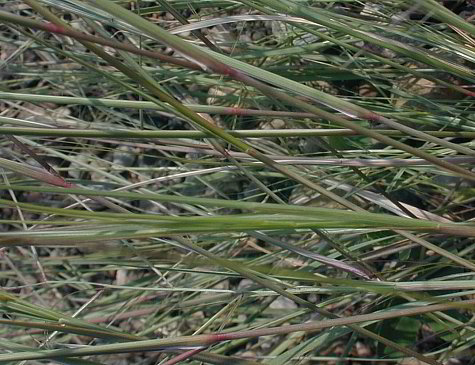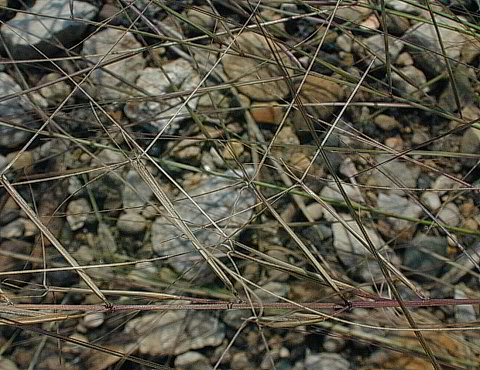Description: This grass is a summer annual that is tufted at the base, producing several culms up to 2' long. The culms can be erect or sprawl across the ground, branching at each node. Each slender culm is light greyish green to pale purple, somewhat flattened, and hairless. Relative to the orientation of each culm, the blades of the alternate leaves are erect to slightly spreading. These leaf blades are up to 3½" (9 cm.) long and up to 1/16" (1.5 mm.) across; they are linear in shape, light greyish green to pale purple, and hairless. The leaf sheaths are light greyish green to pale purple, hairless, and finely ribbed. The ligules lack significant hairs or papery membranes. The nodes are hairless and often reddish.

The upper branches
of each culm terminate in racemes or panicles of spikelets up to 8"
long. Each raceme or panicle produces relatively few spikelets. Each
spikelet consists of a pair of awned glumes and an awned fertile lemma.
The glumes are about ¾–1" long, linear in shape, and keeled; each glume
has a short straight awn. The fertile lemma is about ½–¾" long and
linear in shape; it has 3 awns that bend sharply near the base and they
are about 1–2½" long. The spikelets are nearly sessile or they have
slender pedicels up to 1/3" (1 cm.) long. These spikelets are initially
greyish green to pale purple, but they become various shades or grey or
brown as they mature. Later, the entire plant (culms, leaves, and
spikelets) becomes straw-colored. The blooming period occurs during the
late summer and early fall. Each spikelet produces a single grain. The
awned lemmas can be blown about by the wind, which helps to distribute
the grains to new areas. The root system is fibrous. This grass
reproduces by reseeding itself.
Cultivation:
The preference is full sun, dry conditions, and a barren soil that
consists of gravel, sand, or clay. This grass does best in areas with
scant vegetation and is quite drought resistant.
Range & Habitat:
The native Prairie Three-Awn is a fairly common grass that occurs in
most areas of
Illinois (see Distribution
Map). However, it is even more common in drier areas to the
west of the state. Habitats include dry gravel prairies, sand prairies,
glades, overgrazed pastures, abandoned fields, roadsides, areas along
railroads, and barren waste areas. In Illinois, Prairie Three-Awn is
primarily a railroad weed.

Faunal
Associations:
In Illinois and the lower Midwest, wildlife makes little use of Aristida
spp. (Three-Awn grasses). Some leafhoppers that feed on
Three-Awn grasses include Flexamia picta and Flexamia
pyrops. Small rodents eat the seeds in the desert southwest,
but they have access to better sources of food in the lower Midwest.
Photographic Location:
Along a railroad in Urbana, Illinois.
Comments:
This is the most common Aristida sp. (Three-Awn
grass) in Illinois. Some of the less common Three-Awn grasses in the
state are often found in dry sand prairies. The most striking feature
of these grasses are the bent awns of their fertile lemmas. Prairie
Three-Awn differs from many other Three-Awn grasses by the long awns of
its fertile lemmas (at least 1" long). Other Three-Awn grasses have
awns up to ¾" long (in some species, this applies only to their lateral
awns, which are shorter than the central awns). An exception is Aristida
tuberculosa (Needle Grass), which has awns on its lemmas that
are about as long as those of Prairie Three-Awn. However, the awns of
Needle Grass coil tightly around each other to form a basal column
about ½" long, after which they bend away from each other in the manner
of other Three-Awn grasses. The awns of Prairie Three-Awn and other
Three-Awn grasses are free to the base, or they coil around each other
to form a short basal column that is only 1/8" long.